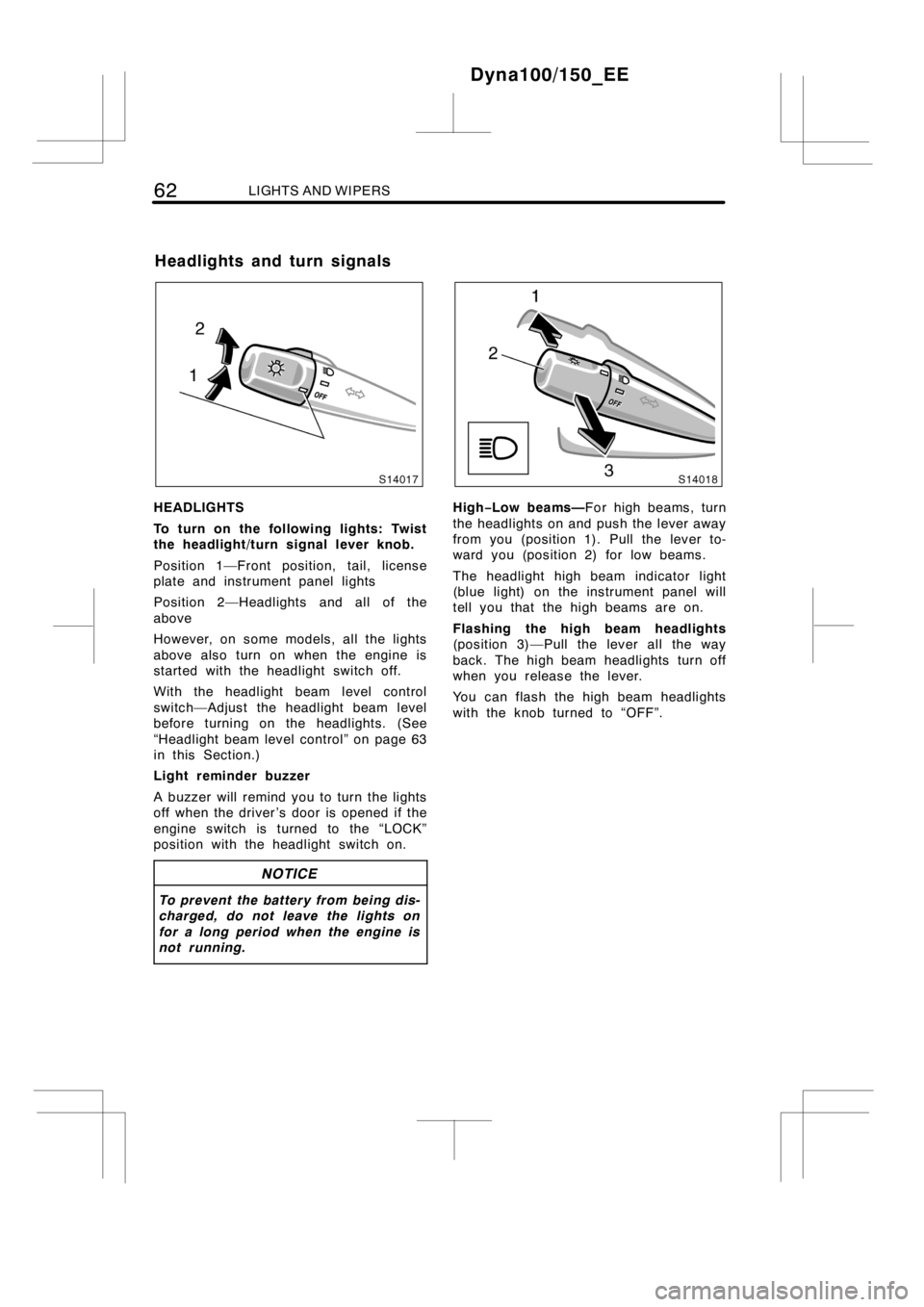2014 TOYOTA DYNA 100/150 door lock
[x] Cancel search: door lockPage 27 of 232

KEYS AND DOORS21
1. To unlock the fuel tank cap, insert
the key and turn it counterclockwise.
When refueling, turn off the engine.
CAUTION
DDo not smoke, cause sparks or al-
low open flames when refueling.
The fumes are flammable.
DWhen opening the cap, do not re-
move the cap quickly. In hot weath-
er, fuel under pressure could cause
injury by spraying out of the filler
neck if the cap is suddenly re-
moved.
2. To remove the fuel tank cap, turn
the cap slowly counterclockwise,
then pause slightly before removing
it.
It is not unusual to hear a slight swoosh
when the cap is opened.When installing,
make sure the tabs in the cap are proper-
ly aligned with the cutouts in the tank
opening. Then lock the cap by turning the
key clockwise.
CAUTION
DMake sure the cap is tightened se-
curely to prevent fuel spillage in
the event of an accident.
DDue to the regulation of fuel tank
pressure that these caps provide,
Toyota recommends to use a genu-
ine Toyota fuel tank cap. Another
fuel tank cap of matching quality
can also be used.
Dyna100/150_EE
Fuel tank cap
Page 68 of 232

62LIGHTS AND WIPERS
HEADLIGHTS
To turn on the following lights: Twist
the headlight/turn signal lever knob.
Position 1—Front position, tail, license
plate and instrument panel lights
Position 2—Headlights and all of the
above
However, on some models, all the lights
above also turn on when the engine is
started with the headlight switch off.
With the headlight beam level control
switch—Adjust the headlight beam level
before turning on the headlights. (See
“Headlight beam level control” on page 63
in this Section.)
Light reminder buzzer
A buzzer will remind you to turn the lights
off when the driver ’s door is opened if the
engine switch is turned to the “LOCK”
position with the headlight switch on.
NOTICE
To prevent the battery from being dis-
charged, do not leave the lights on
for a long period when the engine is
not running.
High−Low beams—For high beams, turn
the headlights on and push the lever away
from you (position 1). Pull the lever to-
ward you (position 2) for low beams.
The headlight high beam indicator light
(blue light) on the instrument panel will
tell you that the high beams are on.
Flashing the high beam headlights
(position 3)—Pull the lever all the way
back. The high beam headlights turn off
when you release the lever.
You can flash the high beam headlights
with the knob turned to “OFF”.
Dyna100/150_EE
Headlights and turn signals
Page 84 of 232

78GAUGES, METERS AND SERVICE REMINDER INDICATORS
(j) Timing Belt Replacement Warning
Light
This light will come on every time when
the trip amount gets between 140000 km
and 150000 km in kilometer reading or
90000 miles in mile reading to indicate
that the timing belt should be replaced.
When it comes on, have the belt replaced
and the warning light reset by any autho-
rized Toyota dealer or repairer, or another
duly qualified and equipped professional.
NOTICE
Continued driving without having the
belt replaced will result in a broken
belt and engine damage.
(k) Fuel Filter Warning Light
The light warns you that the amount of
accumulated water in the fuel filter has
reached the specified level.
If it comes on, drain the water immediate-
ly. (See page 192 in Section 7−2for
instructions for how to drain the water.)
NOTICE
Never drive the vehicle with the warn-
ing light on. Continued driving with
water accumulated in the fuel filter
will damage the fuel injection pump.
(l) Engine Oil Change Reminder Light
This light comes on to remind you to
change the engine oil and oil filter.
If the light comes on, change the engine
oil and oil filter at your earliest conve-
nience. For detailed information, see “Oil
maintenance managementsystem” on
page 70 in this Section.(m) Light Reminder Buzzer
This buzzer will sound if the driver ’s door
is opened while the engine switch is
turned to the “LOCK” position with the
headlight switch on. Removing the key will
not stop the buzzer as long as the head-
light switch is on.
CHECKING SERVICE REMINDER
INDICATORS (except the low fuel level
warning light)
1. Apply the parking brake.
2. Turn the engine switch to the “ACC”
position.
The SRS warning light should come on.
It goes off after about 6 seconds.
3. Turn the engine switch to the “ON”
position, but do not start the engine.
All the service reminder indicators ex-
cept the SRS warning light should
come on. The “ABS” warning light goes
off after a few seconds. The engine oil
change reminder light goes off after
about 5 seconds.
If any service reminder indicator or warn-
ing buzzer does not function as described
above, have it checked by any authorized
Toyota dealer or repairer, or another duly
qualified and equipped professional, as
soon as possible.
Dyna100/150_EE
Page 136 of 232

130STARTING AND DRIVING
Keep the door locks from freezing.
Squirt lock de−icer or glycerine into the
locks to keep them from freezing. To open
a frozen lock, try heating the key before
inserting it.
Use a washer fluid containing an anti-
freeze solution.
This product is available at any authorized
Toyota dealer or repairer and most auto
parts stores or another qualified professio-
nal. Follow the manufacturer ’s directions
for how much to mix with water.
NOTICE
Do not use engine antifreeze or any
other substitute because it may dam-
age your vehicle’s paint.
Do not use your parking brake when
there is a possibility it could freeze.
When parking, put the transmission into
first or reverse and block the front
wheels. Do not use the parking brake, or
snow or water accumulated in and around
the parking brake mechanism may freeze,
making it hard to release.
Keep ice and snow from accumulating
under the fenders.
Ice and snow built up under your fenders
can make steering difficult. During bad
winter driving, stop and check under the
fenders occasionally.
Depending on where you are driving,
we recommend you carry some emer-
gency equipment.
Some of the things you might put in the
vehicle are tire chains, window scraper,
bag of sand or salt, flares, small shovel,
jumper cables, etc.Your vehicle is designed primarily as a
passenger−and−load−carrying vehicle. Tow-
ing a trailer will have an adverse effect on
handling, performance,braking,durability
and driving economy (fuel consumption,
etc.). Your safety and satisfaction depend
on the proper use of correct equipment
and cautious driving habits. For your safe-
ty and the safety of others, you must not
overload your vehicle or trailer. Ask your
local authorized Toyota dealer or repairer,
or another duly qualified and equipped
professional, for further details before tow-
ing, as there are additional legal require-
ments in some countries.
WEIGHT LIMITS
Before towing, confirm the towing capacity,
gross vehicle mass (GVM), maximum per-
missible axle capacity (MPAC) and draw-
bar load. They are listed on page 214 in
Section 8.
When towing a trailer, observe the follow-
ing:
DThe total trailer weight (trailer weight
plus its cargo load) is within the towing
capacity.
DWhen the total trailer weight is greater
than the vehicle weight, we recommend
the use of a friction stabilizer (sway
control device).
DWhen the total trailer weight is over
2000 kg (4409 lb.), a friction stabilizer
(sway control device) is required.
Dyna100/150_EE
Trailer towing
Page 172 of 232

166IN CASE OF AN EMERGENCY
DBefore emergency towing, check that
the hook or eyelet is not broken or
damaged and that the installation bolts
are not loose.
DFasten the towing cable or chain se-
curely to the hook or eyelet.
DDo not jerk the hook or eyelet. Apply
steady and even force.
DTo avoid damaging the hook or eyelet,
do not pull from the side or at a verti-
cal angle. Always pull straight ahead.You can purchase a new key at any
authorized Toyota dealer or repairer, or
another duly qualified and equipped
professional, if you can give them the
key number.
See the suggestion given in “Keys” on
page 12 in Section 1−2.
If your key is locked in the vehicle and
you cannot get a duplicate, many autho-
rized Toyota dealers, repairers or other
duly qualified and equipped professionals
can still open the door for you, using their
special tools. If you must break a window
to get in, we suggest breaking the side
window because it is the least expensive
to replace. Be extremely cautious to avoid
cuts from the glass.
Dyna100/150_EE
—Emergency towing hook or
eyelet precautionsIf you lose your keys
Page 225 of 232

SPECIFICATIONS219
Instrument panel
Left side of the vehicle
Fuses (type A)
1. CIG 15 A:Cigarette lighter
2. DOOR 30 A:Power door locksystem
3. IG1−NO.2 10 A:Gauges and meters,
service reminder indicators and warning
buzzer, back−up lights, back buzzer
4. WIP 30 A: Windshield wipers and
washer
5. A/C 10 A:Air conditioningsystem
6.IG110A:Back−up lights, back buzzer
7. TRN 10 A:Turn signal lights, emergen-
cy flashers
8. ECU−IG 10 A:Anti−lock brake system9. RR−FOG 10 A:Rear fog light
10. OBD 10 A:On−board diagnosissystem
11 . D O M E 1 0 A :Interior lights
12. ECU−B10A:Headlights, tail lights
13. TAIL 15 A:Tail lights, front position
lights, license plate lights, instrument
panel lights, rear fog light
14. H−LP LL 10 A (vehicle with daytime
running light system):Left−hand
headlight (low beam)
15. H−LP RL 10 A (vehicle with daytime
running light system):Right−hand
headlight (low beam)
16. H−LP LH 10 A (vehicle with daytime
running light system) or H−LP LH 15
A (vehicle without daytime running
light system):Left−hand headlight
(high beam)
17. H−LP RH 10 A (vehicle with daytime
running light system) or H−LP RH 15
A (vehicle without daytime running
light system):Right−hand headlight
(high beam)
18. HORN 10 A:Horns
19. HAZ 10 A:Emergency flashers
20. STOP 10 A:Stop lights
21. ST 10 A:Starting system
22.IG210A:SRS airbag system
23.A/CNO.210A:Air conditioning sys-
tem
24. SPARE 10 A:Spare fuse
25. SPARE 15 A:Spare fuse
26. SPARE 20 A:Spare fuse
27. SPARE 30 A:Spare fuse
28. FOG 15A:Fog light
29. F/HTR 30 A:Front heater
30. EFI1 10 A:Engine control system
31. ALT−S10A:Charging system, charg-
ing system warning light
32.AM210A:Engine switch
Dyna100/150_EE
Fuses
Page 226 of 232

220SPECIFICATIONS
33. A/F 15A:A/F
34. ECD 25 A:Engine control system
35. E−FA N 3 0 A :Electric cooling fan
36. EDU 20A:EDU
Fuse (type B)
37. POWER 30 A:Power window, power
door locksystem
38. PTC1 50 A:PTC heater
39. PTC2 50 A:PTC heater
40.AM130A:Engine switch, “CIG”, “AIR
BAG” and “GAUGE” fuses
41. HEAD 40 A:Headlights
42. MAIN1 30 A:“HAZ”, “HORN”, “STOP”
and “ECU−B” fuses
43. ABS 50 A:Anti−lock brake system
44. HTR 40 A:Air conditioningsystem
45. P−MAIN 30A:Electric cooling fan
46. P−COOL RR HTR 40A:Air conditioning
system
47.ABS230A:Anti−lock brake system
Fuse (type C)
48.MAIN350A:“TRN”, “ECU−IG”, “IG1”,
“A/C”, “WIP” and “DOOR” fuses
49.MAIN250A:“OBD”, “TAIL”, “DOME”,
“RR−FOG” and “POWER” fuses
50. ALT 140 A:Charging system
51. GLOW 80 A:Engine glow system
52. ST 60 A:Starting system
Dyna100/150_EE
Page 228 of 232

222INDEX
A
Adding washer fluid 204..................
Adjustment
Driver ’s seat 25.......................
Seat belt 28...........................
Air bleeding 142.........................
Air conditioning filter 93..................
Air conditioningsystem 84...............
Airbag 38...............................
Anti−lock brake system
warning light 73.......................
Anti−theft steering column lock 80........
Appearance care
Cleaning the interior 173...............
Protecting your Toyota from
corrosion 170.......................
Washing and waxing 171...............
Auxiliary box 102........................
B
Battery
Access 182...........................
Checking battery condition 200.........
Gas caution 200.......................
Handling safety 200...................
Recharging precautions 202............
Winter driving tips 129.................
Before starting the engine 124............
Brake pad wear indicators 119............
Brake system 116.......................
Brake system warning light 73............
Brakes
Pad wear indicators 119................
Parking 82............................
Break−in tips 108........................
C
Carbon monoxide caution 114............
Card holder 104.........................
Center console box 103..................
Charging system warning light 73.........
Checking and replacing fuses 203........
Checking the engine oil level 188.........
Checking the radiator, condenser and
intercooler 192........................Child restraint
Child restraint system 45...............
Installation 48,51......................
Precautions 44........................
Types of child restraint system 46.......
Cigarette lighter and ashtrays 100........
Cleaning the interior 173.................
Cold weather
Operation 129.........................
Condenser
Checking the condenser 192...........
Controls, Instrument panel 2,6...........
Cooling system
Coolant level 190......................
Engine overheating 148................
Radiator and reservoir 190.............
Radiator cap 148......................
Winter driving tips 129.................
Corrosion prevention 170................
Cup holder 102..........................
D
Diesel particulate filter system 110........
Differential, Limited slip 120..............
Dimmer switch, Headlight 62.............
Directional signals 62....................
Do−it−yourself maintenance
Service precautions 185...............
Does your vehicle need repairing? 177....
Doors
Side doors 13.........................
DPF system 110.........................
Driver ’s seat 25.........................
Driving
Driving tips 124........................
Manual transmission 81................
Driving in the rain 128....................
Driving tips
Driving in the rain 128..................
Driving tips in various conditions 127....
Driving with a manual
transmission 81.....................
Economical driving 138................
Good driving practice 81...............
Pre−trip safety check 126..............
Winter driving tips 129.................
During
Break−in 108..........................
Dyna100/150_EE